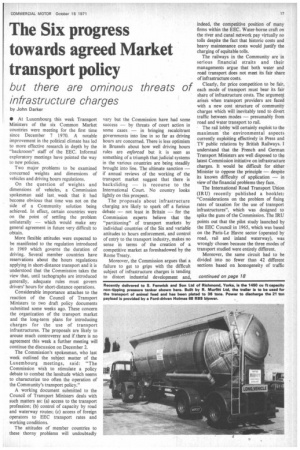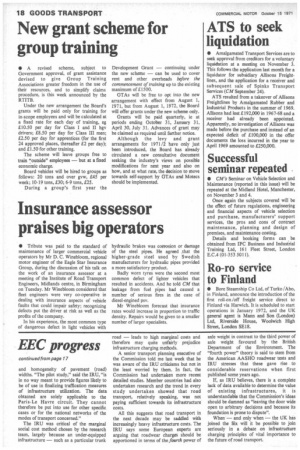The Six progress towards agreed Market transport policy
Page 19

Page 20

If you've noticed an error in this article please click here to report it so we can fix it.
but there are ominous threats of infrastructure charges
by John Darker • At Luxembourg this week Transport Ministers of the six Common Market countries were meeting for the first time since December 7 1970. A notable improvement in the political climate has led to more effective research in depth by the "backroom" staff of the EEC. Informal exploratory meetings have pointed the way to new policies.
Two major problems to be examined concerned weights and dimensions of vehicles and driving hours regulations.
On the question of weights and dimensions of vehicles, a Commission spokesman said last, week that it had become obvious that time was not on the side of a Community solution being achieved. In effect, certain countries were on the point of settling the problem unilaterally — which would make any general agreement in future very difficult to obtain.
More flexible attitudes were expected to be manifested to the regulation introduced in 1969 which governs the duration of driving. Several member countries have reservations about the hours regulations applying in short-distance transport and it is understood that the Commission takes the view that, until tachographs are introduced generally, adequate rules must govern drivers' hours for short-distance operations.
Considerable importance attaches to the reaction of the Council of Transport Ministers to two draft policy documents submitted some weeks ago. These concern the organization of the transport market and the long-term plans for introducing charges for the use of transport infrastructures. The proposals are likely to arouse much controversy and if there is no agreement this week a further meeting will continue the discussion on December 2.
The Commission's spokesman, who last week outlined the subject matter of the Luxembourg meetings, said: "The Commission wish to stimulate a policy debate to combat the lassitude which seems to characterize too often the operation of the Community's transport policy."
A working document submitted to the Council of Transport Ministers deals with such matters as: (a) access to the transport profession; (b) control of capacity by road and waterway routes; (c) access of foreign operators to EEC transport rates and working conditions.
The attitudes of member countries to these thorny problems will undoubtedly
vary but the Commission have had some success — by threats of court action in some cases — in bringing recalcitrant governments into line in so far as driving hours are concerned. There is less optimism in Brussels about how well driving hours rules are enforced but it is seen as something of a triumph that judicial systems in the various countries are being steadily brought into line. The ultimate sanction — if annual reviews of the working of the transport market suggest that there is backsliding — is recourse to the International Court. No country looks lightly on this prospect.
The proposals about infrastructure charging are likely to spark off a furious debate — not least in Britain — for the Commission experts believe that the "partitioning" of transport markets by individual countries of the Six and variable attitudes to hours enforcement, and control of entry to the transport industry, makes no sense in terms of the creation of a competitive market as foreshadowed by the Rome Treaty.
Moreover, the Commission argues that a failure to get to grips with the difficult subject of infrastructure charges is tending to distort industrial development and, indeed, the competitive position of many firms within the EEC. Water-borne craft on the river and canal network pay virtually no tolls despite the fact that historic costs and heavy maintenance costs would justify the charging of equitable tolls.
The railways in the Community are in serious financial straits and their managements argue that both water and road transport does not meet its fair share of infrastructure costs.
Clearly, for price competition to be fair, each mode of transport must bear its fair share of infrastructure costs. The argument arises when transport providers are faced with a new cost structure of community charges which will inevitably tend to divert traffic between modes — presumably from road and water transport to rail.
• The rail lobby will certainly exploit to the maximum the environmental aspects currently exploiting effectively in Press and TV public relations by British Railways. I understand that the French and German Transport Ministers are well disposed to the latest Commission initiative on infrastructure charges. It would be difficult for either Minister to oppose the principle — despite its known difficulty of application — in view of the financial problems they face.
The International Road Transport Union (IRU) recently published a booklet: "Considerations on the problem of fixing rates of taxation for the use of transport infrastructures", which was designed to spike the guns of the Commission. The IRU points out that the pilot study launched by the EEC Council in 1965, which was based on the Paris-Le Havre sector (operated by road, rail and inland waterway), was wrongly chosen because the three modes of transport studied were entirely different.
Moreover, the same circuit had to be divided into no fewer than 42 different sections based on homogeneity of traffic
and homogeneity of pavement (road) widths. "The pilot study," said the IRU, "is in no way meant to provide figures likely to be of use in finalizing traffication measures of infrastructure utilization. The data obtained are solely applicable to the Paris-Le Havre circuit. They cannot therefore be put into use for other specific cases or for the national networks of the modes of transport concerned."
The IRU was critical of the marginal social cost method chosen by the research team, largely because an under-equipped infrastructure — such as a particular trunk
road — leads to high marginal costs and therefore may quite unfairly prejudice infrastructure charging methods.
A senior transport planning executive of the Commission told me last week that he was aware of the IRU criticisms but not in the least worried by them. In fact. the Commission had undertaken more recent detailed studies. Member countries had also undertaken research and the trend in every study undertaken showed that road transport, relatively speaking, was not paying sufficient towards its infrastructure costs.
All this suggests that road transport in the next decade may be saddled with increasingly heavy infrastructure costs. The IRU says some European experts are arguing that roadwear charges should be apportioned in terms of the fourth power of axle weight in contrast to the third power of axle weight favoured by the British Department of the Environment. The "fourth power" theory is said to stem from the American AASHO roadwear tests and IRU stresses that these gave rise to considerable reservations when first published some years ago.
If, as IRU believes, there is a complete lack of data available to determine the value of existing infrastructures, it is understandable that the Commission's ideas should be damned as "leaving the door wide open to arbitrary decisions and because its foundation is prone to dispute".
When — and only when — the UK has joined the Six will it be possible to join seriously in a debate on infrastruCture charging principles of vital importance to the future of road transport,
















































































































